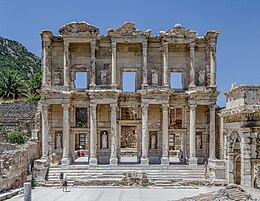262 Southwest Anatolia earthquake

The contents of the Library of Celsus at Ephesus were destroyed by a fire in 262 C.E. caused either by an earthquake or by an invasion. The façade was toppled in another earthquake centuries later and reerected in 1970–78.
|
|
| Date | 262 |
|---|---|
| Epicenter | 36°30′N 27°48′E / 36.5°N 27.8°ECoordinates: 36°30′N 27°48′E / 36.5°N 27.8°E |
| Areas affected | Turkey |
| Max. intensity | IX (Violent) |
| Tsunami | Estimated at Intensity 4 on the Sieberg-Ambraseys scale |
The 262 Southwest Anatolia earthquake devastated the Roman city of Ephesus along with cities along the west and south coasts of Anatolia in year 262, or possibly 261. The epicenter was likely located in the southern Aegean Sea. Reports note that many cities were flooded by the sea, presumably due to a tsunami.
Nicholas Ambraseys, who performed the most comprehensive assessment of ancient earthquakes in the Mediterranean, traces the original source of most literary references to this quake to an account in the Augustan History purportedly written by Trebellius Pollio. This source is problematic, as the veracity of much of its supposed biographical details is doubtful. However, there is some reason to give credence to the history's accounts of natural disasters. Trebellius's account also reports the southwest Anatolia earthquake in conjunction with one that hit Cyrene, Libya the same year. The two events appears to have been unrelated, but it has been difficult for historians to disentangle the exact effects of each based on the classical sources.
There are many faults in the Aegean Sea and the adjacent coastal areas of Anatolia, caused by the African Plate being subducted beneath the Aegean Sea Plate. These faults result in frequent earthquakes. Ephesus, which sustained considerable damage in the 262 AD earthquake, was also struck by earthquakes in AD 17, sometime before AD 30, c. AD 42, c. AD 46–47, c. 150–155, 358–366, 614, and the tenth or eleventh century. One fault in the southern part of the region stretches from the island of Rhodes in present-day Greece northeastwards to Burdur in present-day Turkey.
Trebellius wrote that the cities of Roman Asia reported the worst damage from the earthquake: "In many places the earth yawned open, and salt water appeared in the fissures. Many cities were even overwhelmed by the sea." He records that this damage occurred took place during the consulship of Gallienus and Fausianus. The latter appears to be Lucius Mummius Faustianus who was a consul in the year 262.
...
Wikipedia

